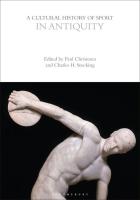
Bloomsbury (2024) p/b 264pp £25.99 (ISBN 9781350460980)
This is the first of six volumes on the cultural history of sport throughout the ages to the present day. It covers the period from the end of the Aegean Bronze Age (c. 1100 BC) to the end of the Roman period in AD 476.
It contains essays by eight academics in North America and Europe and covers the purpose of sport, venues and frequency, rules, competitiveness, social status, the contribution of sport to personal well-being, and the conventions for the artistic representation of athletes.
The contributors call upon the extensive literary evidence associated with the pre-eminent games, especially what are known as the ‘Crown Games’ i.e. the Olympic, Pythian, Isthmian and Nemean Games, where the prizes were crowns made, respectively, from olive, laurel, wild celery and pine. It is noted that Herodotus observes that the absence of a financial prize prompted one of the Persian invaders to ask their leaders: ‘What kind of men did you lead us here to fight, who compete not for money but for excellence alone?’ There is, however, evidence that money prizes were offered to gladiatorial contests (in the Romanised games) and ‘one day of the festival [the Olympics] was devoted to a variety of musical and artistic competitions for which cash prizes were offered to the actors.’
One contributor discusses the place of records (i.e. best performances) in antiquity, arguing (perhaps ingenuously) that it was not impossible to compare achievements in ancient races as access to water clocks was available, though it is difficult to see how such clocks could be relied on like a modern stopwatch, especially in short sprint events. ‘Records’ to the ancients meant the recording of the names of the winners.
One comes across fascinating social details. Women, who had little opportunity for participation in sport, still found their way to make their mark: there is an inscription on a statue of a chariot and horses that was erected at Olympia, in which Kyniska, the daughter of a Spartan king celebrates the victory of her chariot, adding ‘And I declare that I alone from women of all Greece seized this crown.’ (It was not the charioteer but the owner of the chariot who was counted as the winner). There is an excursus on early Christian attitudes to sport and St Paul’s use of training for sport as a metaphor for Christian self-discipline.
The whole book with its thoroughly researched and argued conclusions is a mine of interesting and thought-provoking details and discussions. With a number of black and white illustrations both of statuary and of sporting scenes on pottery, a comprehensive bibliography and well put-together index, this scholarly volume is to be highly commended.
Ray Morris
